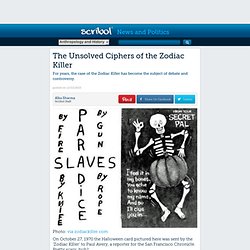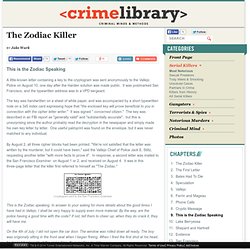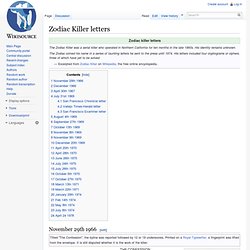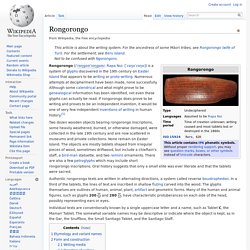

The Unsolved Ciphers of the Zodiac Killer. For years, the case of the Zodiac Killer has become the subject of debate and controversy.

Photo: via zodiackiller.com On October 27, 1970 the Halloween card pictured here was sent by the ‘Zodiac Killer’ to Paul Avery, a reporter for the San Francisco Chronicle. Pretty scary, huh? The memories of this year’s Halloween may be fading, but it makes sense to be wary of any suspicious person following you and perhaps not go out there alone after dark. If you were to forget these words of warning, the thought of the Zodiac Killer might serve as a reminder. He claimed to have murdered 37 people in his letters to the San Francisco Chronicle. Photo: via zodiackiller.com This letter was another piece of evidence. Photo: via zodiackiller.com This most mysterious story began on the night of December 20, 1968. Then, while people were trying to come to terms with of the shocking news, a mysterious call was received at Vallejo Police Department less than month later. Photo: via Wikipedia. Letters of the Zodiac Killer — This is the Zodiac Speaking. A little-known letter containing a key to the cryptogram was sent anonymously to the Vallejo Police on August 10, one day after the Harden solution was made public.

It was postmarked San Francisco, and the typewritten address was to a VPD sergeant. The key was handwritten on a sheet of white paper, and was accompanied by a short typewritten note on a 3x5 index card expressing hope that "the enclosed key will prove beneficial to you in connection with the cipher letter writer. " It was signed " concerned citizen. " The key was described in an FBI report as "generally valid" and "substantially accurate", but this is unsurprising since the author probably read the decryption in the newspaper and simply made his own key letter by letter. One useful palmprint was found on the envelope, but it was never matched to any individual. By August 2, all three cipher blocks had been printed. Zodiac Killer letters. November 29th 1966[edit] Possibly a reproduction of the letter December 1966[edit] Sick of living/unwilling to die cut. clean. if red /

Zodiac Killer Letters. December 1966 Riverside Desk-Top Poem 1 | 2 July 31, 1969 Times-Herald Letter | Cipher 1/3 | Envelope July 31, 1969 Examiner Letter | Cipher 2/3 | Envelope July 31, 1969 Chronicle Letter | Cipher 3/3 | Envelope August 1969 Debut Of "Zodiac" Letter Oct. 13, 1969 Stine Letter | Envelope Nov. 8, 1969 Dripping-Pen Card | Cipher | Envelope Nov. 9, 1969 Bus-Bomb Letter | Envelope Dec. 20, 1969 Belli Letter | Envelope April 20, 1970 "My name is...

" Rongorongo. Rongorongo (/ˈrɒŋɡoʊˈrɒŋɡoʊ/; Rapa Nui: [ˈɾoŋoˈɾoŋo]) is a system of glyphs discovered in the 19th century on Easter Island that appears to be writing or proto-writing.

Numerous attempts at decipherment have been made, none successfully. Although some calendrical and what might prove to be genealogical information has been identified, not even these glyphs can actually be read. If rongorongo does prove to be writing and proves to be an independent invention, it would be one of very few independent inventions of writing in human history.[1] Two dozen wooden objects bearing rongorongo inscriptions, some heavily weathered, burned, or otherwise damaged, were collected in the late 19th century and are now scattered in museums and private collections.
None remain on Easter Island. And 280 , have characteristic protuberances on each side of the head, possibly representing ears or eyes. Etymology and variant names[edit] Rongorongo by Sergei V. Rjabchikov. Rongorongo. But there have also been claims that rongorongo is actually a syllabary once you figure out how to decompose it into the right number of basic units (around 70 for Rapanui). This includes Macri in the Daniels and Bright volume, and also Konstantin Pozdniakov, in: Pozdniakov, Konstantin. 1996.
"Les bases du déchiffrement de l'écriture de l'île de Pâques". , 103(2), pages, 289--303. There is just one teensy little problem with these analyses: neither Macri nor Pozdniakov have published their decomposition, so until they do, there is little reason why one should accept their claims to have found a decomposition. Pozdniakov does a little better than Macri. But Pozdniakov would appear to have merely re-discovered Zipf's law (well, not quite since the populations of syllables are too small for the curves to be truly Zipfian). Rongorongo. Rongorongo script and the Rapanui language.
Origin The people of Easter Island were possibly inspired to invent the Rongorongo script after seeing the writing used by the Spanish when they annexed the island in 1770. The Easter Islanders were apparently impressed by the mana or power of the Spaniards' writing. Rongorongo was used until the 1860s, after which knowledge of the script was lost. Nowadays most Easter Islanders write in Spanish using the Latin alphabet though a few try to write their own language, Rapanui, also with the Latin alphabet. Since missionaries started visiting Easter Island in the 1860s, they have taken an interest in the mysterious Rongorongo symbols. Two other scripts were once used on Easter Island: Ta'u and Mama, but little is known about them as very few inscriptions have been found. Notable features.